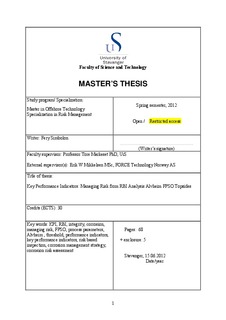| dc.contributor.author | Simbolon, Fery | |
| dc.date.accessioned | 2014-02-06T08:39:04Z | |
| dc.date.issued | 2012 | |
| dc.identifier.citation | Conf. until june 2014 | no_NO |
| dc.identifier.uri | http://hdl.handle.net/11250/182298 | |
| dc.description | Master's thesis in Risk management | no_NO |
| dc.description.abstract | In oil and gas industries, KPIs are normally required in order to evaluate the asset integrity performance. KPIs are selected from the most crucial performance indicators to the asset integrity. KPIs can also be used as a tool to manage risk from RBI analysis on Alvheim FPSO Topside. As part of corrosion management strategy, RBI analysis determines the risk level of each system by calculating the probability of failure (PoF) and consequence of failure (CoF) for particular systems. The risk levels depend on the actual process parameters on Alvheim FPSO Topside thus any change to the process parameters will of course affect the RBI analysis and Alvheim corrosion management system. All changes on the crucial process parameters are captured on the corrosion KPIs.
The purpose of this thesis is to evaluate and improve the corrosion and inspection management system at Alvheim FPSO Topside by developing the performance indicators of all plausible internal degradation mechanisms. The most crucial performance indicators are selected as KPIs. Each KPI has individual thresholds values that need to be compared to the measured data so the percentage of compliance can be determined.
On Alvheim FPSO Topside, it has been noticed that the actual CO2 content in the hydrocarbon system is higher than the threshold KPI. The trend of average corrosion KPI compliance is stagnant due to zero compliance on the CO2 threshold content. Future corrective actions need to be agreed between the corrosion engineer, integrity engineer, process engineer, production engineer and chemical vendor. Further investigation on CO2 corrosion is required; it might be the calculated corrosion rate is too conservative as there have been no findings so far from the last inspection campaign. The most suitable corrective action is to increase the threshold of CO2 content by altering the injecting rate of the corrosion inhibitors. These inhibitors reduce the CO2 corrosion rates thus the threshold of CO2 content can be increased. | no_NO |
| dc.language.iso | eng | no_NO |
| dc.publisher | University of Stavanger, Norway | no_NO |
| dc.relation.ispartofseries | Masteroppgave/UIS-TN-IØRP/2012; | |
| dc.subject | risikostyring | no_NO |
| dc.subject | kpi | no_NO |
| dc.subject | rbi | no_NO |
| dc.subject | integrity | no_NO |
| dc.subject | corrosion | no_NO |
| dc.subject | risk management | no_NO |
| dc.subject | corrosion risk assessment | no_NO |
| dc.subject | process parameters | no_NO |
| dc.subject | corrosion management strategy | no_NO |
| dc.subject | performance indicators | no_NO |
| dc.subject | key performance indicators | no_NO |
| dc.subject | risk based inspection | no_NO |
| dc.title | Key performance indicators: managing risk from rbi analysis alvheim fpso topsides | no_NO |
| dc.type | Master thesis | no_NO |
| dc.subject.nsi | VDP::Social science: 200 | no_NO |
| dc.description.embargo | 2014-06-15 | |
